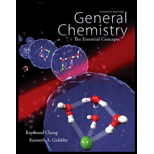
Concept explainers
Interpretation:
Need to calculate the amount of Copper deposited and bromine liberated upon
Concept introduction:
Electrolysis of CuBr2 resulted in the formation of copper and bromine. The cell reaction can be written as follows.
In the given electrolytic process bromide get oxidized at anode to liberate as bromine gas and Cu2+ ion will get reduced to Cu. By calculating the total number of charges that flow through the circuit, the amount of copper deposited can be calculated in successive steps. Since coulomb is the amount of electric charge flowing in a circuit in 1s, when current is 1A. So the above statement can be represented by the following equation.
On dividing the number of charges with Faraday constant we can get the number of moles of electron
From knowing the number of mole of electrons and using the stoichiometry of the reaction, the number of moles of the substance reduced or oxidized can be determined. This can be explained by the representative reaction as shown below.
2 mole of electrons were needed for the reduction of one mole of copper. So the number of moles of copper reduced can be calculated by the following equation.
To find: Amount of copper and bromine produced during the electrolysis of CuBr2 upon passing 4.5 A of current for 1 hour.
Want to see the full answer?
Check out a sample textbook solution
Chapter 19 Solutions
Package: General Chemistry with Connect 2-year Access Card
 ChemistryChemistryISBN:9781305957404Author:Steven S. Zumdahl, Susan A. Zumdahl, Donald J. DeCostePublisher:Cengage Learning
ChemistryChemistryISBN:9781305957404Author:Steven S. Zumdahl, Susan A. Zumdahl, Donald J. DeCostePublisher:Cengage Learning ChemistryChemistryISBN:9781259911156Author:Raymond Chang Dr., Jason Overby ProfessorPublisher:McGraw-Hill Education
ChemistryChemistryISBN:9781259911156Author:Raymond Chang Dr., Jason Overby ProfessorPublisher:McGraw-Hill Education Principles of Instrumental AnalysisChemistryISBN:9781305577213Author:Douglas A. Skoog, F. James Holler, Stanley R. CrouchPublisher:Cengage Learning
Principles of Instrumental AnalysisChemistryISBN:9781305577213Author:Douglas A. Skoog, F. James Holler, Stanley R. CrouchPublisher:Cengage Learning Organic ChemistryChemistryISBN:9780078021558Author:Janice Gorzynski Smith Dr.Publisher:McGraw-Hill Education
Organic ChemistryChemistryISBN:9780078021558Author:Janice Gorzynski Smith Dr.Publisher:McGraw-Hill Education Chemistry: Principles and ReactionsChemistryISBN:9781305079373Author:William L. Masterton, Cecile N. HurleyPublisher:Cengage Learning
Chemistry: Principles and ReactionsChemistryISBN:9781305079373Author:William L. Masterton, Cecile N. HurleyPublisher:Cengage Learning Elementary Principles of Chemical Processes, Bind...ChemistryISBN:9781118431221Author:Richard M. Felder, Ronald W. Rousseau, Lisa G. BullardPublisher:WILEY
Elementary Principles of Chemical Processes, Bind...ChemistryISBN:9781118431221Author:Richard M. Felder, Ronald W. Rousseau, Lisa G. BullardPublisher:WILEY





